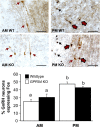The role of kisspeptin-GPR54 signaling in the tonic regulation and surge release of gonadotropin-releasing hormone/luteinizing hormone
- PMID: 17978050
- PMCID: PMC6673361
- DOI: 10.1523/JNEUROSCI.2748-07.2007
The role of kisspeptin-GPR54 signaling in the tonic regulation and surge release of gonadotropin-releasing hormone/luteinizing hormone
Abstract
The Kiss1 gene codes for kisspeptin, which binds to GPR54, a G-protein-coupled receptor. Kisspeptin and GPR54 are expressed in discrete regions of the forebrain, and they have been implicated in the neuroendocrine regulation of reproduction. Kiss1-expressing neurons are thought to regulate the secretion of gonadotropin-releasing hormone (GnRH) and thus coordinate the estrous cycle in rodents; however, the precise role of kisspeptin-GPR54 signaling in the regulation of gonadotropin secretion is unknown. In this study, we used female mice with deletions in the GPR54 gene [GPR54 knock-outs (KOs)] to test the hypothesis that kisspeptin-GPR54 signaling provides the drive necessary for tonic GnRH/luteinizing hormone (LH) release. We predicted that tonic GnRH/LH secretion would be disrupted in GPR54 KOs and that such animals would be incapable of showing a compensatory rise in LH secretion after ovariectomy. As predicted, we found that GPR54 KO mice do not exhibit a postovariectomy rise in LH, suggesting that tonic GnRH secretion is disrupted in the absence of kisspeptin-GPR54 signaling. We also postulated that kisspeptin-GPR54 signaling is critical for the generation of the estradiol (E)-induced GnRH/LH surge and thus E should be incapable of inducing an LH surge in the absence of GPR54. However, we found that E induced Fos expression in GnRH neurons and produced a GnRH-dependent LH surge in GPR54 KOs. Thus, in mice, kisspeptin-GPR54 signaling is required for the tonic stimulation of GnRH/LH secretion but is not required for generating the E-induced GnRH/LH surge.
Figures






References
-
- Adachi S, Yamada S, Takatsu Y, Matsui H, Kinoshita M, Takase K, Sugiura H, Ohtaki T, Matsumoto H, Uenoyama Y, Tsukamura H, Inoue K, Maeda K. Involvement of anteroventral periventricular metastin/kisspeptin neurons in estrogen positive feedback action on luteinizing hormone release in female rats. J Reprod Dev. 2007;53:367–378. - PubMed
-
- Clifton DK, Sawyer CH. LH release and ovulation in the rat following depletion of hypothalamic norepinephrine: chronic vs. acute effects. Neuroendocrinology. 1979;28:442–449. - PubMed
-
- Clifton DK, Sawyer CH. Positive and negative feedback effects of ovarian steroids on luteinizing hormone release in ovariectomized rats following chronic depletion of hypothalamic norepinephrine. Endocrinology. 1980;106:1099–1102. - PubMed
Publication types
MeSH terms
Substances
Grants and funding
LinkOut - more resources
Full Text Sources
Molecular Biology Databases
Research Materials
